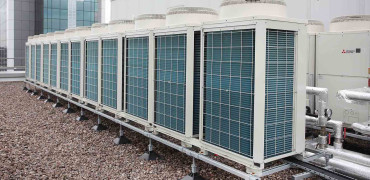This month, we are celebrating the 10th anniversary of our unique and pioneering Hybrid VRF (Variable Refrigerant Flow) air conditioning system which delivers the flexibility of design and performance of a VRF system, combined with many of the benefits normally associated with a water-based chiller system.
This innovative heating and cooling solution answers the need for occupant comfort, energy efficiency and carbon reduction.
Since Hybrid VRF was originally developed over a decade ago, the construction industry has evolved, and we have seen an increase in legislation focusing on reducing the impact of climate change.
Whilst it is still delivering everything it was developed for, the benefits of Hybrid VRF have also become highly relevant in today’s market answering carbon reduction demands and helping limit the amount of flammable refrigerant inside buildings.
Hybrid VRF was well ahead of its time and is still providing answers to the challenges facing buildings
Occupied spaces
One of the reasons we developed Hybrid VRF was to combat the issue of refrigerant leakage in occupied spaces for BS EN378 compliance. Another was to start to address the F-Gas phasedown by using less refrigerant in our systems.
Hybrid VRF uses R32 refrigerant between the outdoor compressor and an internal branch controller (HBC). From that point onwards, water is used as the medium to transfer energy, meaning that there is no refrigerant in occupied spaces and no need for leak detection equipment, or the inconvenience of annual leak detection system maintenance.
It still provides the flexibility of design and operation that has made VRF air conditioning the market leader in the commercial sector, but the use of water in most of the Hybrid VRF system means that the off-coil temperatures are gentler for occupants.
We have seen lots of Hybrid VRF installed in many hotels such as the Strand Palace Hotel in London, the Hotel du Vin in Stratford upon Avon, or the Haymarket Hotel in Edinburgh.
It has also been installed in city centre accommodation and in a respite home for Ronald McDonald, along with countless offices throughout the country as more realise how installation can be quicker with plastic water piping reducing the need for hot pipework.
A decade later
Things have changed over the last 10 years and the original problems that Hybrid VRF was designed to solve have become almost a secondary issue, with more important problems relating to global warming and carbon emissions – Thankfully, Hybrid VRF is up to the task and is helping offer a solution to these issues right now.
With the use of new refrigerants with a lower Global Warming Potential (GWP) comes an increased risk of flammability, so the ability to help remove or reduce the volume of refrigerants from inside buildings and occupied spaces is making more designers look at Hybrid VRF as an option.
Ten years ago, flammable refrigerants were rarely an issue in building services, but they increasingly are now – Hybrid VRF helps solve this problem.
Combined with this is the fact the Hybrid VRF also helps to reduce the embodied carbon of the building services and delivers the best compromise of whole life carbon.
Ten years ago, embodied carbon was rarely considered as an issue in building services, but it certainly is now – Hybrid VRF helps solve this problem.
And a decade ago, water-based systems were in direct competition with refrigerant-based systems but now, the largest water-based equipment manufacturers are also the largest refrigerant-based system manufacturers.
We always knew that Hybrid VRF was well ahead of its time, and on its 10th Anniversary, it is still providing answers to the challenges facing buildings and acting as a bridge between these different industries.
Chris Newman is Zero Carbon Design Manager




